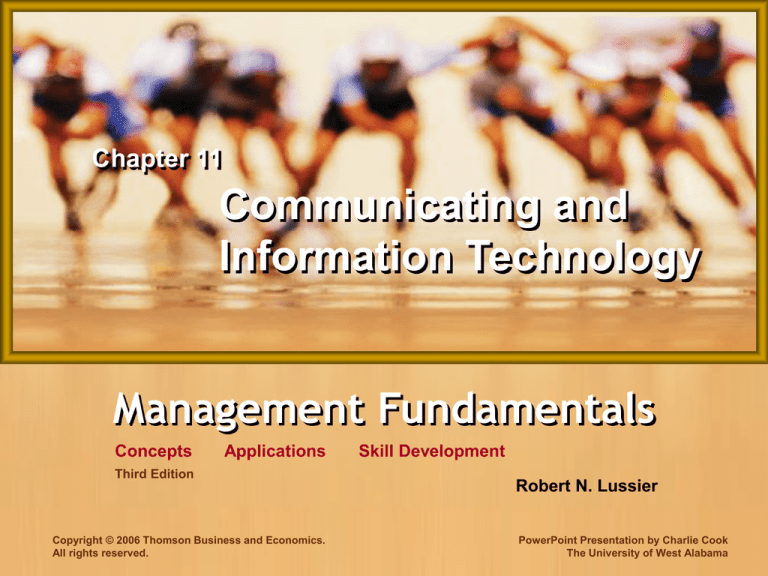
Chapter 11
Communicating and
Information Technology
Management Fundamentals
Concepts
Applications
Third Edition
Copyright © 2006 Thomson Business and Economics.
All rights reserved.
Skill Development
Robert N. Lussier
PowerPoint Presentation by Charlie Cook
The University of West Alabama
Learning Outcomes
After studying this chapter, you should be able to:
1. Describe the three ways communication flows through
organizations.
2. List the four steps in the interpersonal communication process.
3. State the major advantages of oral communication and written
communication.
4. State a general guide to channel selection.
5. List the five steps in the process of sending face-to-face
messages.
6. Describe paraphrasing, and explain why it is useful.
7. List and explain the three parts of the process of receiving
messages.
Copyright © 2006 Thomson Business and Economics. All rights reserved.
11–2
Learning Outcomes (cont’d)
8. Define reflecting responses, and state when they should be
used.
9. Discuss what should and should not be done to calm an
emotional person.
10. Describe the three primary types of information systems and
their relationship.
11. List the components of an information network.
Copyright © 2006 Thomson Business and Economics. All rights reserved.
11–3
Learning Outcomes (cont’d)
12. Define the following key terms:
communication
vertical communication
horizontal communication
grapevine
communication process
encoding
communication channel
decoding
nonverbal communication
message-sending process
feedback
paraphrasing
message-receiving process
reflecting responses
empathic listening
Copyright © 2006 Thomson Business and Economics. All rights reserved.
11–4
Organizational Communication
•
Vertical Communication
–
•
Horizontal Communication
–
•
_________________________________________________
_________________________________________________
_________________________________________________
_________________________________________________
Grapevine
–
_________________________________________________
_________________________________________________
Copyright © 2006 Thomson Business and Economics. All rights reserved.
11–5
Information Technology
•
Data
–
•
_________________________________________________
Information
–
–
_________________________________________________
_________________________________________________
Useful information is:
1. _____________________________________________
2. _____________________________________________
_____________________________________________
3. _____________________________________________
_____________________________________________
Copyright © 2006 Thomson Business and Economics. All rights reserved.
11–6
Information Technology (cont’d)
•
Information Technology (IT)
–
•
The Internet
–
•
_________________________________________________
_________________________________________________
_________________________________________________
_________________________________________________
Business Portal
–
_________________________________________________
_________________________________________________
_________________________________________________
Copyright © 2006 Thomson Business and Economics. All rights reserved.
11–7
Information Technology (cont’d)
•
Databases
–
•
_________________________________________________
_________________________________________________
_________________________________________________
_________________________________________________
Wireless Communication
–
_________________________________________________
_________________________________________________
_________________________________________________
_________________________________________________
Copyright © 2006 Thomson Business and Economics. All rights reserved.
11–8
Oral Communication
• Advantages
• Disadvantages
– _____________________
– _____________________
– _____________________
Copyright © 2006 Thomson Business and Economics. All rights reserved.
– _____________________
_____________________
11–9
Nonverbal Communication
•
Nonverbal Communication
–
–
–
_________________________________________________
Body language
• _____________________________________________
• _____________________________________________
• _____________________________________________
• _____________________________________________
Disadvantage
• _____________________________________________
_____________________________________________
Copyright © 2006 Thomson Business and Economics. All rights reserved.
11–10
Written Communication
• Advantages
• Disadvantages
– _____________________
_____________________
Copyright © 2006 Thomson Business and Economics. All rights reserved.
– _____________________
_____________________
– _____________________
_____________________
11–11
Selecting the Message Transmission Channel
•
Media Richness
–
_________________________________________________
_________________________________________________
• Oral channels ________________________________
_____________________________________________
• Written channels ______________________________
_____________________________________________
• Combined channels ___________________________
_____________________________________________
Copyright © 2006 Thomson Business and Economics. All rights reserved.
11–12
Sending Messages
• Planning the Message
–
–
–
–
–
_________________________________________
_________________________________________
_________________________________________
_________________________________________
_________________________________________
Copyright © 2006 Thomson Business and Economics. All rights reserved.
11–13
The Message-Sending Process
1.
2.
3.
4.
5.
Exhibit 11–5
Copyright © 2006 Thomson Business and Economics. All rights reserved.
11–14
Checking Understanding: Feedback
•
Feedback
–
•
Paraphrasing
–
•
_________________________________________________
_________________________________________________
_________________________________________________
Feedback Problems
–
–
–
_________________________________________________
_________________________________________________
_________________________________________________
Copyright © 2006 Thomson Business and Economics. All rights reserved.
11–15
Checking Understanding: Feedback (cont’d)
•
How to Get Feedback
–
–
–
–
_________________________________________________
_________________________________________________
_________________________________________________
_________________________________________________
_________________________________________________
_________________________________________________
_________________________________________________
_________________________________________________
Copyright © 2006 Thomson Business and Economics. All rights reserved.
11–16
Response Styles
• Advising
• Reassuring
– ________________________
________________________
________________________
• Diverting
– ________________________
________________________
________________________
• Reflecting
– ________________________
________________________
________________________
– ________________________
________________________
________________________
• Probing
– ________________________
________________________
________________________
Copyright © 2006 Thomson Business and Economics. All rights reserved.
11–17
Dealing With Emotional People
•
Dimensions of Emotional Intelligence
1. _________________________________________________
2. _________________________________________________
3. _________________________________________________
4. _________________________________________________
5. _________________________________________________
Copyright © 2006 Thomson Business and Economics. All rights reserved.
11–18
Dealing With Emotional People (cont’d)
• Dealing with Emotional People
– _________________________________________
– _________________________________________
– _________________________________________
• Reflective Empathic Listening
– _________________________________________
_________________________________________
Copyright © 2006 Thomson Business and Economics. All rights reserved.
11–19
Criticism
• Giving Criticism
– _________________________________________
– _________________________________________
• Getting Criticism
– _________________________________________
– _________________________________________
Copyright © 2006 Thomson Business and Economics. All rights reserved.
11–20
Types of Information Systems (IS)
•
Transaction Processing Systems (TPS)
–
•
Management Information Systems (MIS)
–
–
•
_________________________________________________
_________________________________________________
_________________________________________________
_________________________________________________
Executive Information Systems (EIS)
–
–
_________________________________________________
_________________________________________________
Copyright © 2006 Thomson Business and Economics. All rights reserved.
11–21
Types of Information Systems (IS) (cont’d)
• Decision Support Systems (DSS)
– _________________________________________
_________________________________________
– _________________________________________
_________________________________________
– _________________________________________
_________________________________________
Copyright © 2006 Thomson Business and Economics. All rights reserved.
11–22
Information Networks
•
Information Networks
–
_________________________________________________
_________________________________________________
_________________________________________________
_________________________________________________
–
P2P: ____________________________________________
–
B2C: ____________________________________________
_________________________________________________
–
B2B: ____________________________________________
_________________________________________________
Copyright © 2006 Thomson Business and Economics. All rights reserved.
11–23






